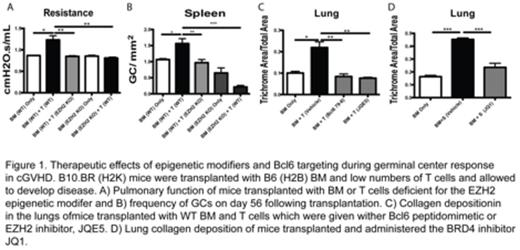Abstract

To study transcriptional pathways and develop targeted therapeutics for cGVHD, we studied the effects of emerging therapeutic agents targeting GCs. BCL6 is a master regulatory transcription factor, which facilitates GC development in a cooperative manner with emerging chromatin-associated factors, namely the EZH2 lysine methyltransferase and the BRD4 epigenetic reader protein. Using a murine multi-organ system cGVHD model induced by low T cell numbers, we have shown that cGVHD is dependent on pathogenic antibodies and the GC reaction. To determine whether strategies that disrupt GC integrity could be used to treat cGVHD we targeted Bcl6 using a direct-acting ligand (79-6), EZH2 using three structurally-distinct inhibitors (JQ-E, UNC1999 and DZNep), and a first-in-class BRD4 inhibitor (JQ1). In T cells, Bcl6 is selectively expressed in T follicular helper and regulatory cells. Using donor T cells from a Bcl6-mCherry reporter, we observed a 10-fold increase in % of CD4+/mCherry+ splenic T cells in cGVHD vs bone marrow (BM) only controls on d56. The small-molecule Bcl6 inhibitor 79-6 was synthesized and used to treat mice with active cGVHD from d28-56. Treatment reversed cGVHD-induced bronchiolitis obliterans (BO) measured by d56 pulmonary function tests (PFTs). This correlated with a 2-fold decrease in GC B cells and decrease in lung collagen (Fig 1 C). EZH2 catalyzes the methylation of lysine 27 on histone 3 (H3K4me3) silencing genes to a transcriptionally repressive state. EZH2 is massively upregulated during the GC reaction, and prevents GC B cell terminal differentiation, allowing affinity maturation to occur. Furthermore, naive T cells express low EZH2 levels, EZH2 is rapidly upregulated upon allostimulation.To determine whether EZH2 expression in donor BM or splenic T cells was critical for cGVHD, recipients were given wild type (WT) vs EZH2 floxed, Cg1-Cre (for B cell specific EZH2 deletion) BM + WT T cells, WT BM + EZH2 floxed, CD4-Cre vs WT T cells or WT BM + WT T cells. EZH2 deletion in either BM-derived B cells or splenic T cells completely prevented cGVHD (Fig 1 A) with a decrease in d56 splenic GC frequency (Fig 1 B). We compared 3 drugs that reduce H3K4me3: two pyridinone inhibitors, which inhibit SAM-dependent methylation (JQ-E and UNC1999) and DZNep, which destabilizes EZH2 complexes. At established doses given d28-56, DZNep and UNC1999 were ineffective or toxic, respectively. In contrast, JQ-E fully reversed cGVHD lung dysfunction and fibrosis around the bronchioles was significantly decreased (Fig 1 C). JQ1 is a first in class epigenetic reader that recognizes histone modifications and has been shown to reduce B cell lymphomas via inhibiting super-enhancer-associated transcripts and to treat cardiac failure-induced fibrosis. JQ1 given to cGVHD mice d28-56 significantly inhibited BO as assessed by PFTs and collagen deposition (Fig 1 D). Taken together, these data demonstrate for the first time the critical role of Bcl6 and targeting of histones that affect the transcriptional repressive states via EZH2 and a BET bromodomain epigenetic reader. These data provide a strong foundation for clinical trials of inhibitors that directly or epigenetic modifiers and readers that indirectly target Bcl6.
No relevant conflicts of interest to declare.
Author notes
Asterisk with author names denotes non-ASH members.

This icon denotes a clinically relevant abstract


This feature is available to Subscribers Only
Sign In or Create an Account Close Modal